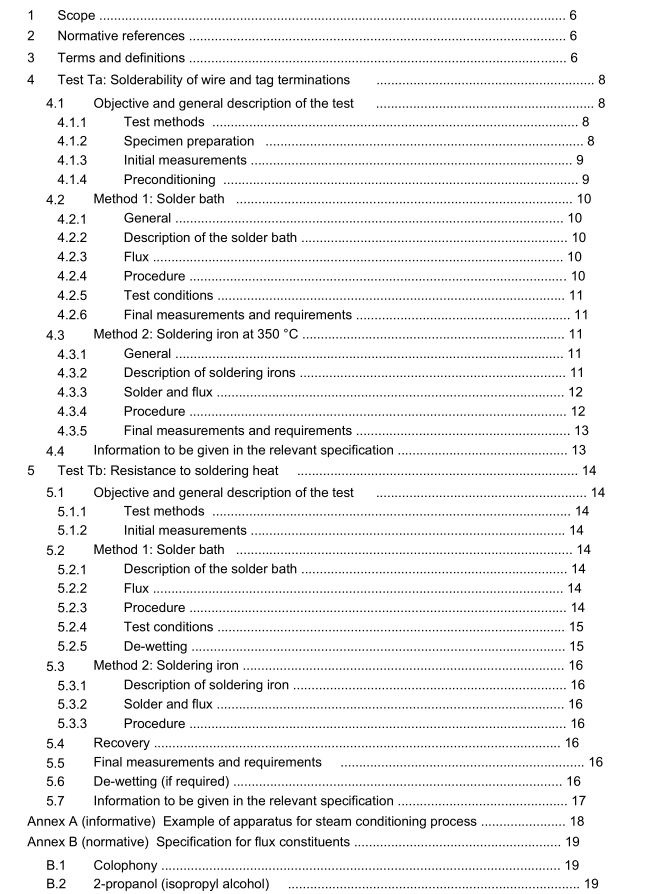IEC 60068-2-20 pdf – Environmental testing – Part 2-20: Tests – Tests Ta and Tb: Test methods for solderability and resistance to soldering heat of devices with leads

IEC 60068-2-20 pdf – Environmental testing – Part 2-20: Tests – Tests Ta and Tb: Test methods for solderability and resistance to soldering heat of devices with leads
1 Scope
This part of lEC 60068 outlines Tests Ta and Tb, applicable to devices with leads and leadsthemselves. Soldering tests for surface mounting devices (SMD) are described inIEC 6o068-2-58.
This document provides procedures for determining the solderability and resistance to solderingheat of devices in applications using solder alloys, which are eutectic or near eutectic tin lead(Pb), or lead-free alloys.
The procedures in this document include the solder bath method and soldering iron method.
The objective of this document is to ensure that component lead or termination solderabilitymeets the applicable solder joint requirements of IEC 61191-3 and IEC 61191-4. In addition,test methods are provided to ensure that the component body can be resistant to the heat load
to which it is exposed during soldering.
NOTEInformation about wetting time and wetting force can be obtained by test methods using a wetting balance.IEC 60068-2-69 (solder bath and solder globule method) can be consulted.
2 Normative references
The following documents are referred to in the text in such a way that some or all of their contentconstitutes requirements of this document. For dated references, only the edition cited applies.
For undated’ references, the latestedition of the referenced document(including anyamendments) applies.
IEC 60068-1,Environmental testing – Part 1: General and guidance
IEC 60068-2-2,Environmental testing – Part 2-2:Tests – Test B: Dry heat
IEC 60068-2-66,Environmental testing – Part 2:Test methods -Test Cx: Damp heat, steadystate (unsaturated pressurized vapour)
IEC 60068-2-78,Environmental testing – Part 2-78:Tests – Test Cab: Damp heat, steady state
IEC 61191-3,Printed board assemblies – Part 3: Sectional specification – Requirements forthrough-hole mount soldered assemblies
IEC 61191-4,Printed board assemblies – Part 4: Sectional specification – Requirements forterminal soldered assemblies
3 Terms and definitions
For the purposes of this document, the following terms and definitions apply.
ISO and IEC maintain terminological databases for use in standardization at the followingaddresses:
. IEC Electropedia: available at http://www.electropedia.orgl
. Iso Online browsing platform: available at http://www.iso.org/obp3.1
colophony
natural resin obtained as the residue after removal of turpentine from the oleo-resin of the pine
tree,consisting mainly of abietic acid and related resin acids,the remainder being resin acidesters
Note 1 to entry:“Rosin” is a synonym for colophony,and is deprecated because of the common confusion with thegeneric term “resin”.
3.2
contact angle
in general, the angle enclosed between two planes, tangent to a liquid surface and a solid/liquidinterface at their intersection (see Figure 1); in particular, the contact angle of liquid solder incontact with a solid metal surface
4Test Ta: Solderabilityof wire and tag terminations4.1Objective and general description of the test
4.1.1Test methods
Test Ta provides two different test methods to determine the solderability of areas on wire andtag terminations that are required to be wetted by solder during the assembly operation.
-Method 1: solder bath;
-Method 2: soldering iron.
The test method to be used shall be indicated in the relevant specification. The solder bathmethod is the one which most closely simulates the soldering procedures of flow soldering and
similar soldering processes.
The soldering iron method may be used in cases where Method 1 is impracticable.
lf required by the relevant specification, the test specimen shall be preconditioned according to4.1.4.The following are typical methods for preconditioning:
Type 1a:
1 h steam
Type 1b:
4 h steam
Type 2:
10 days damp heat, steady state condition (40 ±2)°C; (93± 3) %RH (Test Cab)
Type 3a:4 h at 155 °C dry heat (Test Bb)
Type 3b:
16 h at 155 °C dry heat (Test Bb).
Type 4:
4 h unsaturated pressurized vapour (Test Cx)
NOTE 1 In general, the acceleration for ageing prior to solderabiliytesting is estimated by simulating thedegradationin storage environment. However,the steam ageing conditiondoes not correspond with storageconditions because the failure mode derived from steam ageing is clearly different from that derived from storagecondtions. Therefore,an accelerated correlation between steam ageing and natural ageing in storage condition isimpossible and steam ageing conditions such as type 1a and type 1b are inapproprlate as accelerated ageing.
NOTE 2 For Ni/Au surface,Type 2 or Type 4 is appropriate as preconditioning.
4.1.2Specimen preparation
The surface to be tested shall be in the “as received” condition and shall not be subsequentlytouched by the fingers or otherwise contaminated.









